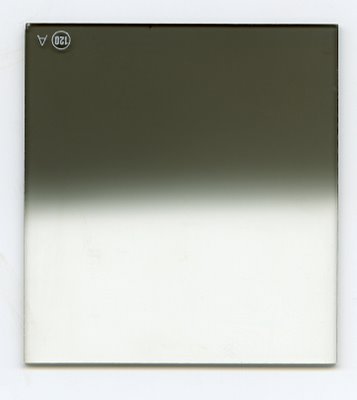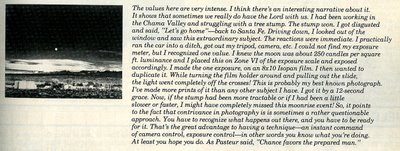A French Connection & The Other Darwin
Tuesday, November 25, 2008

Some 29 years ago I went Claudia Beck and Andrew Gruft's Nova Gallery on 4th Avenue and saw a print (printed by the photographer) of Moonrise Over Hernandez, New Mexico by Ansel Adams. It was superb hanging in the middle of the room suspended by wires from the ceiling. For many of us this was the Holy Grail of the landscape photograph. It was the perfect landscape. We knew that Adams had been able to take but one exposure from a camera on a tripod on the roof of his pickup. We also knew that the one exposure was close to perfect because Adams knew the luminance value of the full moon. For many who dabbled in landscape they would often say that Adams's pictures were good only because he had the money and patience to wait for the best light.
What is the best light? As an example consider the problem of a landscape that has three separate areas.
1. A dramatic sky with puffy or storm clouds.
2. A middle region that is often a mountain chain with snow capped peaks.
3. A third region which us usually a valley (streams or lakes) in the shadow of the mountain range.
No b+w film or slide film can accommodate the three values. If you expose for the dramatic sky the snow on the peaks will go gray and the valley will be black. If you over-expose to get detail in the valley the snow will lose its detail and the sky will be disappointing. Adams waited for the best light and had his own personal trick that he called his Zone System. It worked with separate sheets of b+w film in larger formats but it failed with transparency or slide film.
For many years pristine and perfect landscapes were rare. We photographers would be wowed when we saw them. There was a large postcard demand for these pristine landscapes.
Then about 40 years ago a French company called Cokin revolutionized landscape photography with the mass distribution of its partial neutral density filters which were made of plastic. They were relatively expensive and you really had to take care of them as they scratched easily. Here you see such an example. This filter was large enough for most of my 35mm wide angle lenses. If you positioned the dark area on the top of the lens, the darkness would prevent light from entering your camera and exposing your film. As you took an exposure that was correct for that dark valley the neutral density (meaning it did not add or subtract colour) the resulting overexposure on the dark dramatic cloud was compensated by the top half of the Cokin filter. These filters came in all sort of gradations with narrower or darker bands of darkness. Then Coking came up with coloured neutral density filters. Instead of dark areas these areas would be in colour. The most popular was a reddish one that was called the tobacco filter. These filters started creeping into movies particularly the ones that were about the rosier time of yesteryear or in old cheddar TV ads (this is the way we used to make our cheese and this is still the same way we make it now).
One of the first things I did after marrying Rosemary in 1968 (but there is no connection) was getting a membership (this was before the magazine went public and you could buy it in newsstands or get a subscription) to the National Geographic. Thanks to the inept and corrupt Mexican postal system I never got more than 8 issues per year. I vowed to someday move to a country were I would get all 12 issues per year. This finally happened in 1975 when we moved to Vancouver. At the time I was dazzled by the photography of the magazine. But it was also at this time that Cokin was making itself known and I was disappointed and dismayed to see photograph in the Geographic (Robert Louis Stevenson's tomb on top Mount Vaea on Upolu, Samoa) at about that time that had used the tobacco filter. The photographer had not waited for the light. The photographer had cheated.
I am happy to report that the Geographic from my vantage point has become again a magazine that is most important in my life. The photographs of animals in the current issue (December) in an article on Alfred Russel Wallace are terrific and the article so interesting I am going to look for a biography on this man that the Geographic calls The Other Darwin. The magazine is a delight to read as it no longer seems to tow the US political line and when it reports on a country that is a dictatorship is says so. At one time the Geographic photographers would keep the horizon near the bottom of the picture. You never saw the squalor, the poverty or the dirt. That is long gone as the horizon has increasingly moved upwards.
Cokin is still in business but the digital camera industry will soon probably do it in. Photographers are now able to shoot that landscape (the sky, the mountain range, the valley) in three separate exposures and there are many cheap programs that will meld all three exposures seamlessly. If you pick up any photo magazine your eyes will soon grow tired or even blind to the page after page of perfect landscapes in intense colours. The reflections of the mountains on the lake are as perfect as the mountains themselves.
Looking back at the picture of Stevenson's tomb on Samoa I now don't see it so much as a travesty. It was only a modification of existing conditions that film could not handle. The eye can look at those three separate aspects of the landscape. It is the camera with film that fails. Now landscapes can all be perfect. As perfect as all those photographs of perfect models that even lack pores in their faces.

Can it be that we will no longer be thrilled by a picture taken from the roof of pickup as a one shot?






